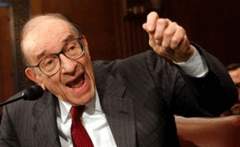|
 |
| Federal Reserve Chairman Alan Greenspan appears
before the Senate Banking, Housing and Urban Affairs Committee on
Capitol Hill Wednesday, April 6, 2005. At its meeting Tuesday, May
3, 2005,the Fed is poised to raise the federal funds rate by
one-quarter of one percentage point, to 3 percent. That would be the
eighth such increase since June 2004, when the central bank began
its campaign to tighten credit. (AP) |
Federal Reserve, worried about rising
inflation , pushed a key interest
rate higher Tuesday and signaled that Americans' borrowing costs are
likely to keep climbing in the months ahead.
In response, commercial banks began lifting their prime lending rates,
which are used for many short-term consumer and business loans.
Federal Reserve Chairman Alan Greenspan and his colleagues, sticking to
a course of gradually raising rates, nudged up the federal funds rate by
one-quarter of a percentage point, to 3 percent. It was the eighth
increase of that size since the Fed began to tighten credit last June, and
it left the rate at the highest level since the fall of 2001.
Banks' prime lending rates were rising a quarter-point to 6 percent,
also the highest since 2001.
The federal funds rate, the interest banks charge each other on
overnight loans, is now triple the 1 percent rate - a 46-year low - that
prevailed before the Fed embarked on its rate-raising campaign.
Fed policy-makers, walking a tightrope, are confronted with two
challenging economic forces: rising inflation pressures on the one hand
and slowing economic growth on the other.
Higher interest rates are a defense against rising inflation. But when
it is more expensive to borrow money, some consumers and businesses are
less inclined to spend and invest, factors that would further chill an
already cooling economy.
The policy-makers, in a brief statement issued after their closed-door
meeting, acknowledged that the economy had hit a rough patch in early
spring. "The solid pace of spending growth has slowed somewhat, partly in
response to the earlier increases in energy prices," they said.
Oil prices soared into record territory in March and hit a new peak of
$57.27 a barrel at the beginning of April - straining household and
business budgets. Prices have since retreated and settled at $49.50 a
barrel on Tuesday.
The Fed also drew fresh attention to rising prices in general.
"Pressures on inflation have picked up in recent months and pricing
power is more evident," the statement said, a reference to businesses
finding it easier to raise prices to customers. But it tempered that
inflation warning with an assessment that longer-term inflation
expectations remain "well contained." That phrase was inadvertently
omitted from the Fed's statement. It later issued a corrected version to
include it.
The Fed also said underlying inflation - which excludes energy and food
prices - is "expected to be contained."
Against that backdrop, the Fed said it could continue on its path of
gradually raising rates. In Fed parlance that is stated as "at a pace that
is likely to be measured." To analysts, that phrase translates into
quarter-point increases.
On Wall Street, the Dow Jones industrials gained 5.25 points to close
at 10,256.95.
Private analysts expect the Fed to boost rates by another quarter-point
at its next meeting June 29-30 and probably through much of this year.
That said, they also believe the Fed's future rate decisions could become
increasingly more dependent on how inflation and economic activity unfold.
"The Fed, while acknowledging the slowdown in the economy, is focused
more on inflation. That means their work is not done," said Stuart
Hoffman, chief economist at PNC Financial Services Group. "The Fed will
become even more of a data hound and not quite as much on automatic pilot"
when it comes to raising rates.
For economists and investors, that's a subtle shift in their
perceptions. At the Fed's previous meeting, on March 22, policy-makers'
hawkish tone about inflation ignited speculation that the central bank
might raise rates more aggressively - possibly by a bolder half-point - in
the summer. That spooked Wall Street, sending stocks tumbling.
Since that meeting, however, the economy has flashed signs of slowing.
Over the first three months of the year, the economy grew at a 3.1
percent annual rate, the slowest in two years as energy prices restrained
spending by individuals and companies. Some economists believe growth in
the April-to-June period could be even less.
Employers added just 110,000 jobs in March, the fewest in eight months.
April's employment report comes out Friday, and economists predict it will
show that 170,000 jobs were created.
Fed policy-makers, however, said labor market conditions "continue to
improve gradually."
Inflation, meanwhile, is climbing. Driven by expensive gasoline and
energy products, overall consumer prices jumped by 0.6 percent in March,
the biggest increase since October.
Even more troubling to economists was the 0.4
percent rise in core inflation - a gauge
that excludes energy and food prices. That was the
largest increase in 2 1/2 years.
(AP) | 